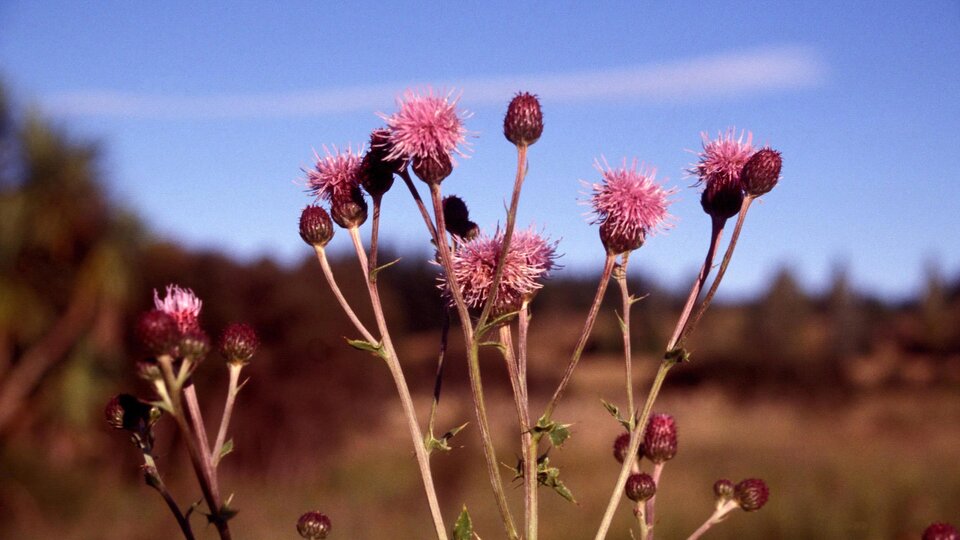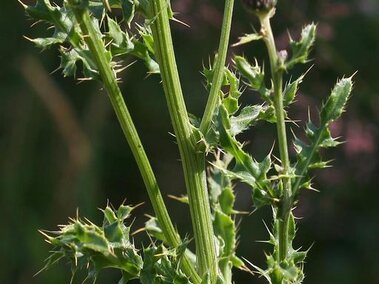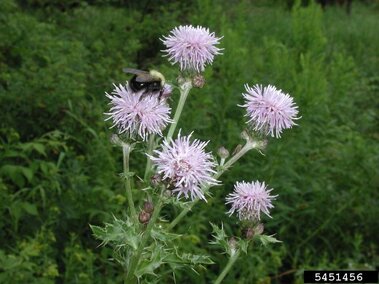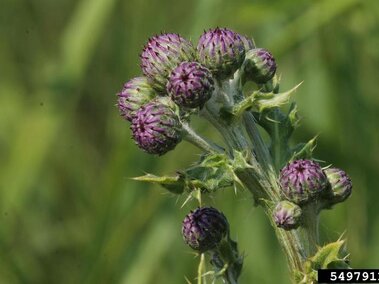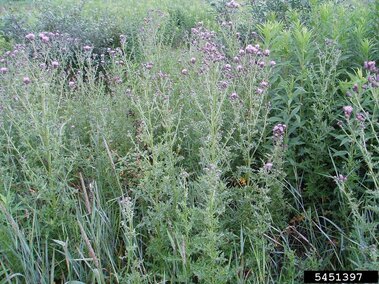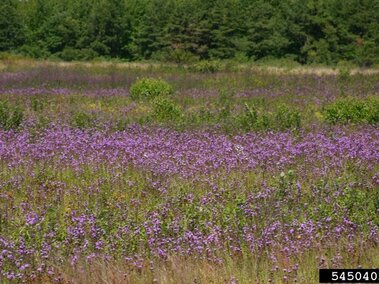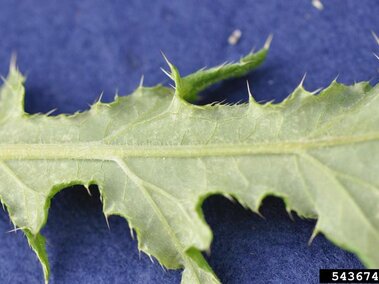General Information
Species Name: Cirsium arvense
Also Known As: California thistle, Californian thistle, Canadian thistle, creeping thistle, corn thistle, field thistle, perennial thistle
Family: Asteraceae (Sunflower)
Growth Form: Forb
Life Span: Perennial
Flowering Dates: June-August
Origin: Asia, Europe, North Africa
Toxic: It may accumulate toxic levels of nitrate.
Noxious: Yes. Canada Thistle is listed as a State Noxious Weed under the Noxious Weed Control Act in Nebraska, which means it is required by law for it to be removed from public and private land in the state.
Watchlist: No
Why Is It Invasive?
Once established, Canada thistle spreads quickly replacing native plants. It grows in circular patches, spreading vegetatively through roots which can spread 10 -12' in one season. It poses an economic threat to the agriculture industry by reducing crop yields.
What Does It Look Like?
General Characteristics
Canada thistle is a widely distributed perennial plant that can grow up to five feet tall. Each plant has a fibrous taproot with wide spreading horizontal roots. Each small section of root can form a new plant, enabling the plant to spread vegetatively.
Flowers
Clusters of tiny pink/purple flowers make up the flower heads. There are smooth green bracts below the flowers that look like small green leaves or scales. The bracts do not have spines on their tips. The flower heads are about ¾ inch long. Canada thistle has male and female flowers on separate plants, but the flowers look similar to each other. Male flowers will not produce seeds. Plants bloom between June and August.
Leaves
Leaves are alternate (come off the stem one at time at each leaf node). Leaves are deeply divided and have spines along the edges.
Stems
Stems generally do not have spines. It has slender, grooved stems.
Seeds
Canada thistle has small seeds with feathery, white tufts to help with wind dispersal, although research has found that most seeds land near the parent plant. Seeds can separate from the white tufts. Seeds remain viable in the soil for over 20 years.
Photos
Where Does It Grow?
Canada thistle invades natural areas such as prairies, savannas, open areas in forests, and dunes if some degree of disturbance already exists. It also invades wet areas with fluctuating water levels such as streambanks, sedge meadows, and wet prairies.
How Does It Spread?
It is suspected that Canada thistle was introduced in contaminated imported crop seed in the 1700s. It reproduces by tufted seeds dispersed by the wind. They can remain viable in the soil for over 20 years. Each plant has a fibrous taproot with deep, wide spreading horizontal roots. Small pieces of root can also grow into new plants.
How Do I Control It?
Canada thistle is difficult to control once it is established on a site. One treatment or a combination of treatments may need to be used to control populations depending on the site.
Mechanical
Contact your county weed control authority to determine appropriate removal methods.
Biological
Natural enemies (biocontrol agents) for control of Canada thistle have been used since the late 1980s in Nebraska. These agents work slowly, and the results may not be seen for many years. These agents are considered a tool to assist in the control of Canada thistle and should never be relied on to completely control any noxious weed. The use of biocontrol agents shall be as effective as the use of herbicides and shall be approved by your local county weed control authority.
Cultural
When buying hay or forage, check to make sure it is weed-free certified. Management should include proper grazing and rotational grazing techniques that would maintain rangelands and prevent invasion. Disturbed areas should be re-seeded with desirable species to prevent spread.
One way that invasive plant seeds and fragments can spread is in soil. Sometimes plants are planted purposefully. You can prevent the spread of invasive plants.
PlayCleanGo: Stop Invasive Species in Your Tracks
REMOVE plants, animals and mud from boots, gear, pets and vehicles.
CLEAN your gear before entering and leaving the recreation site.
STAY on designated roads and trails.
PLANT non-invasive species.
Chemical
Please refer to the 2025 Guide for Weed, Disease and Insect Management in Nebraska or contact your county weed control authority.
What Should I Do If I See It in Nebraska?
If you see Canada thistle in Nebraska, you should report it to your county weed control authority. For guidance on what information to include in your report, check out our reporting tips.
References and More Information
California Invasive Plant Council
Center for Invasive Species and Ecosystem Health
Minnesota Department of Natural Resources
National Invasive Species Information Center
Nebraska Department of Agriculture
Nebraska Weed Control Association
North Carolina Extension Gardener Plant Toolbox
Stubbendieck, J., Coffin, M., & Dunn, C. (2019). Weeds of the Great Plains. Nebraska Department of Agriculture.
